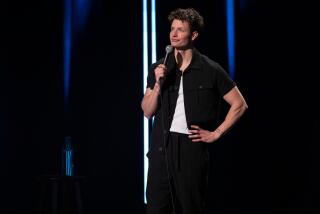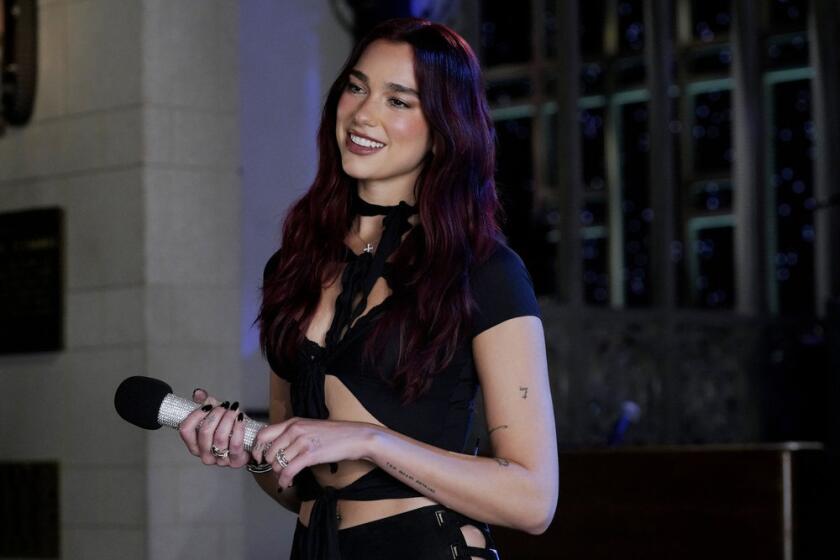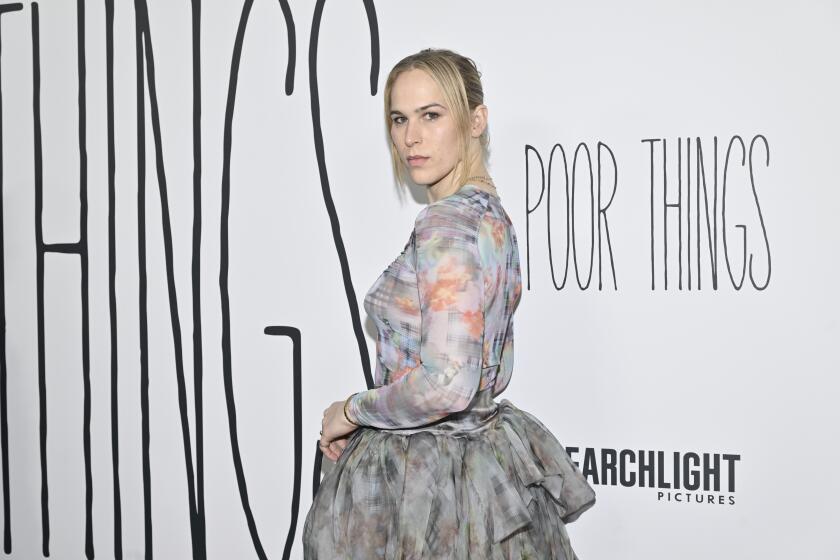The new comedy stages: YouTube, Twitter, online specials
In a sparse room, not much bigger than a walk-in closet, Nick Rutherford sits at an editing bay, head in hand, peering up at half a dozen versions of himself on a giant flat screen. He taps his Converse-clad foot nervously as a video editor assembles the images. It’s the raw footage for his first comedy special. And it’s headed straight to YouTube.
“In the past, if Comedy Central or Showtime or HBO didn’t say, ‘You deserve a special,’ then you didn’t deserve a special,” says Rutherford. “And we’d all accept that.”
But who wants to wait for a cable network to greenlight their career?
“I realized I can do it on my own,” he says. “That’s what YouTubers are all about.”
The reach of digital media — YouTube, Twitter and podcast networks like Earwolf and Nerdist — has allowed comedians to bypass traditional gatekeepers and reach their fans directly.
YouTube, longtime home to funny user-generated videos of giggling babies and piano-playing cats, has invested $100 million to create slick, professional-quality entertainment across 100 new channels, creating opportunities for both established and aspiring comedians. Household names Amy Poehler, Rainn Wilson and Nerdist’s Chris Hardwick all launched dedicated YouTube channels within the last six months.
Louis C.K. grabbed headlines when he produced his own comedy special and sold it to fans online for $5 a pop — famously reaping a cool $1 million in just 10 days. Comedians Aziz Ansari and Jim Gaffigan soon followed suit, helping to redefine how established comedians connect with audiences as well as how newbies can break through to the mainstream.
“Louis’ success proved that if you already have a large, significant following, you don’t need to deal with anyone else,” Ansari says. “You can do something like this yourself.”
These DIY approaches might be daunting to an emerging comedian with far fewer followers than C.K. et al, leaving Rutherford wrestling with his options as he prepares to leap into the digital comedy abyss.
“I could put up the whole thing for free on YouTube or put up a clip and link to my website to buy the longer version. We could go through iTunes,” says Rutherford, who just turned 30 and is a member of the L.A.-based sketch group Good Neighbor. “There are so many options — it’s overwhelming!” (For a taste of Rutherford’s comedy, click here, but beware some adult subject matter and language.)
The special Rutherford is producing with Maker Studios, a Culver City-based entertainment company that specializes in YouTube videos, will be his calling card. Like many young comics, his dream is to land a coveted Comedy Central special, parlay that into a national stand-up tour, then a feature film role and, of course, he jokes, become “super-rich and famous.”
Rob Delaney, who may not be super-rich but is famous on Twitter with 604,000 followers, is another in a growing group of stand-up comedians seizing the digital reins. Inspired by C.K., Ansari and Gaffigan, Delaney recently released his hour-long special, “Live at the Bowery Ballroom,” on his website as a $5 download. Despite his substantial following, it’s still a risky endeavor. Delaney doesn’t have a sitcom to elevate his profile, like C.K. and Ansari, and even his better-known predecessors wrestled over whether the direct-to-fan approach could work without the muscle and infrastructure of a more traditional studio.
“They have much larger Twitter followings. But I spent much less money on my special,” Delaney says. “For me, this is an educational experiment; we’ll see what it yields.”
Despite the risks, Delaney says he feels empowered by his robust and loyal Twitter following. Twitter is one of the main ways he sells tickets to his live shows, which is important because he makes a living primarily by touring. He also uses the succinct nature of Twitter to refine his observational wit; the quick-moving medium, he points out, is perfectly suited to the temperament of comedians.
“Comedians have to be very scrappy and adaptable because comedy is so hard,” Delaney says. “[Our] strength comes from that flexibility. And now comedians are applying that strength to how they do business. People are using new means to get out there. And I think that’s really healthy.”
Comedians have always been a particularly malleable bunch, not only adept at firing off one-liners or responding to hecklers on stage but also adapting to ever-shifting platforms and modifying their performances to suit the new stages.
At the turn of the last century, comedians developed their shtick in vaudeville. Radio gave voice to comedians like the Oklahoma cowboy Will Rogers. Albums in the 1960s were a major way comedians like Bob Newhart, Dick Gregory and Lenny Bruce connected with fans.
With the advent of TV came Johnny Carson’s stamp of approval for stand-up on “The Tonight Show,” launching the careers of Steve Martin, Jerry Seinfeld, David Letterman and many others. Lorne Michaels’ “Saturday Night Live” established sketch as a comedy cornerstone in the ‘70s and ‘80s. Premium cable channels broadened the playing field in the ‘80s and ‘90s; until recently, scoring a TV special on Comedy Central, HBO or Showtime was the gold standard.
That’s changed with the global, boundary-free Internet, says Gabriel Iglesias. He uses highlights from his Comedy Central specials to lure fans to his YouTube channel. That’s where he can reach an even wider audience to promote his live shows and fill 10,000-person stadiums.
“Cable really doesn’t pay a lot,” says Iglesias, producing the second season of Comedy Central’s “Stand-Up Revolution.” “What it costs to produce the show, and what the network is paying to license it, the difference is basically a Honda Accord. I’m not making money on the licensing.”
Walter Latham, who produced the stand-up showcase film “The Original Kings of Comedy” — introducing audiences to, among others, Steve Harvey and the late Bernie Mac — launched his YouTube channel in July. The new comedy channel features clips from his sexually charged “Comedy After Dark” series, video shorts from D.L. Hughley and Michael Blackson, and old-school performances from the likes of Cedric the Entertainer. These days, the promise of online advertising, together with revenue from online services such as Netflix, are potentially more lucrative than a cable TV deal.
“The economics have changed,” says Latham, noting that a one-hour HBO comedy special that a decade ago fetched $500,000 today would bring just $100,000. “You’re fighting and scraping and scrambling trying to get on television.... You are better off [going online where] you have more control over your destiny.”
Viewers are responding. In July, YouTube comedy generated at least 2 billion views on the site and dedicated comedy channels, which attracted 200 million subscribers, according to YouTube head of entertainment Alex Carloss.
“It’s really a reflection of what the YouTube ecosystem represents,” Carloss says. “People have always come to the platform for a laugh, and whatever flavor of comedy they’re into, they can always find it.”
With its slick, professionally created content and the promise of additional ad revenue, many comics now see YouTube not just as a steppingstone to something bigger but as a goal unto itself.
“If you’re in it for the long haul,” says Ben Huh, chief executive and founder of Cheezburger Network, a collection of online humor sites, “and you understand the transformational nature of the Internet, it is the destination.”
Bobby Lee of NBC’s new sitcom “Animal Practice” has a prime-time network comedy but still finds time to film funny YouTube shorts at Maker. Why? “Because this is the future,” he says. “If you’re not part of the next thing, you’re gonna be left out.”
The type of comedy surfacing on YouTube also is evolving. Beyond skateboarding bulldogs, a more structured form of humor can be found online — from video bloggers like Jenna Marbles, who delivers routines directly into a webcam, to sketch comedy routines. And the online mike has never been more open to stand-up. That’s one of the things Rutherford hopes to highlight with his upcoming special.
“Really, my goal with this special is about awareness,” Rutherford says. “Of my own stand-up, and for Good Neighbor, but also of YouTube being a known destination for stand-up now. I hope it shows the new horizon.”
MORE:
INTERACTIVE: TVs highest paid starts
PHOTOS: Hollywood back lot moments
More to Read
The complete guide to home viewing
Get Screen Gab for everything about the TV shows and streaming movies everyone’s talking about.
You may occasionally receive promotional content from the Los Angeles Times.







